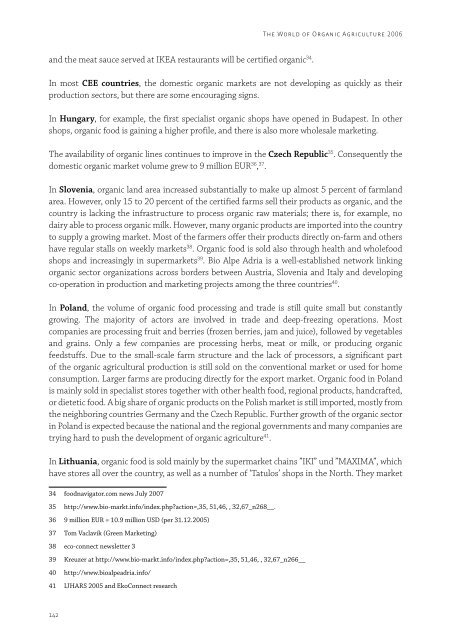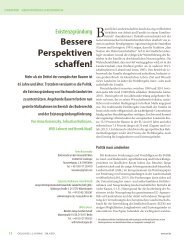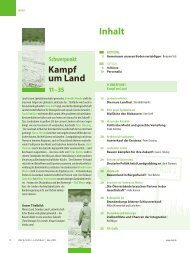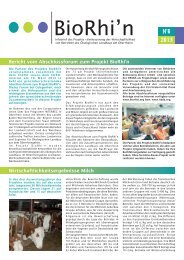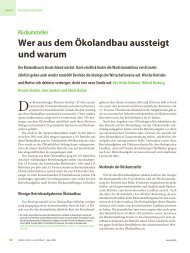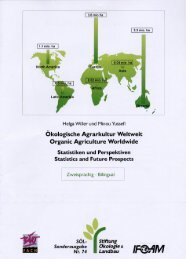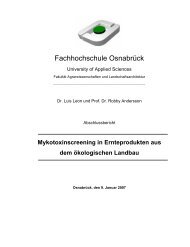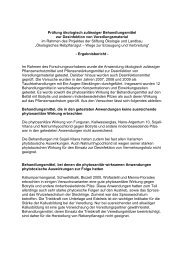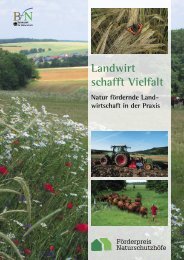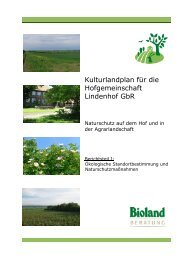the world of organic agriculture - Organic Eprints
the world of organic agriculture - Organic Eprints
the world of organic agriculture - Organic Eprints
Create successful ePaper yourself
Turn your PDF publications into a flip-book with our unique Google optimized e-Paper software.
and <strong>the</strong> meat sauce served at IKEA restaurants will be certified <strong>organic</strong> 34 .<br />
142<br />
The World <strong>of</strong> <strong>Organic</strong> Agriculture 2006<br />
In most CEE countries, <strong>the</strong> domestic <strong>organic</strong> markets are not developing as quickly as <strong>the</strong>ir<br />
production sectors, but <strong>the</strong>re are some encouraging signs.<br />
In Hungary, for example, <strong>the</strong> first specialist <strong>organic</strong> shops have opened in Budapest. In o<strong>the</strong>r<br />
shops, <strong>organic</strong> food is gaining a higher pr<strong>of</strong>ile, and <strong>the</strong>re is also more wholesale marketing.<br />
The availability <strong>of</strong> <strong>organic</strong> lines continues to improve in <strong>the</strong> Czech Republic 35 . Consequently <strong>the</strong><br />
domestic <strong>organic</strong> market volume grew to 9 million EUR 36 , 37 .<br />
In Slovenia, <strong>organic</strong> land area increased substantially to make up almost 5 percent <strong>of</strong> farmland<br />
area. However, only 15 to 20 percent <strong>of</strong> <strong>the</strong> certified farms sell <strong>the</strong>ir products as <strong>organic</strong>, and <strong>the</strong><br />
country is lacking <strong>the</strong> infrastructure to process <strong>organic</strong> raw materials; <strong>the</strong>re is, for example, no<br />
dairy able to process <strong>organic</strong> milk. However, many <strong>organic</strong> products are imported into <strong>the</strong> country<br />
to supply a growing market. Most <strong>of</strong> <strong>the</strong> farmers <strong>of</strong>fer <strong>the</strong>ir products directly on-farm and o<strong>the</strong>rs<br />
have regular stalls on weekly markets 38 . <strong>Organic</strong> food is sold also through health and wholefood<br />
shops and increasingly in supermarkets 39 . Bio Alpe Adria is a well-established network linking<br />
<strong>organic</strong> sector organizations across borders between Austria, Slovenia and Italy and developing<br />
co-operation in production and marketing projects among <strong>the</strong> three countries 40 .<br />
In Poland, <strong>the</strong> volume <strong>of</strong> <strong>organic</strong> food processing and trade is still quite small but constantly<br />
growing. The majority <strong>of</strong> actors are involved in trade and deep-freezing operations. Most<br />
companies are processing fruit and berries (frozen berries, jam and juice), followed by vegetables<br />
and grains. Only a few companies are processing herbs, meat or milk, or producing <strong>organic</strong><br />
feedstuffs. Due to <strong>the</strong> small-scale farm structure and <strong>the</strong> lack <strong>of</strong> processors, a significant part<br />
<strong>of</strong> <strong>the</strong> <strong>organic</strong> agricultural production is still sold on <strong>the</strong> conventional market or used for home<br />
consumption. Larger farms are producing directly for <strong>the</strong> export market. <strong>Organic</strong> food in Poland<br />
is mainly sold in specialist stores toge<strong>the</strong>r with o<strong>the</strong>r health food, regional products, handcrafted,<br />
or dietetic food. A big share <strong>of</strong> <strong>organic</strong> products on <strong>the</strong> Polish market is still imported, mostly from<br />
<strong>the</strong> neighboring countries Germany and <strong>the</strong> Czech Republic. Fur<strong>the</strong>r growth <strong>of</strong> <strong>the</strong> <strong>organic</strong> sector<br />
in Poland is expected because <strong>the</strong> national and <strong>the</strong> regional governments and many companies are<br />
trying hard to push <strong>the</strong> development <strong>of</strong> <strong>organic</strong> <strong>agriculture</strong> 41 .<br />
In Lithuania, <strong>organic</strong> food is sold mainly by <strong>the</strong> supermarket chains ”IKI” und ”MAXIMA”, which<br />
have stores all over <strong>the</strong> country, as well as a number <strong>of</strong> ‘Tatulos’ shops in <strong>the</strong> North. They market<br />
34 foodnavigator.com news July 2007<br />
35 http://www.bio-markt.info/index.php?action=,35, 51,46, , 32,67_n268__.<br />
36 9 million EUR = 10.9 million USD (per 31.12.2005)<br />
37 Tom Vaclavik (Green Marketing)<br />
38 eco-connect newsletter 3<br />
39 Kreuzer at http://www.bio-markt.info/index.php?action=,35, 51,46, , 32,67_n266__<br />
40 http://www.bioalpeadria.info/<br />
41 IJHARS 2005 and EkoConnect research


